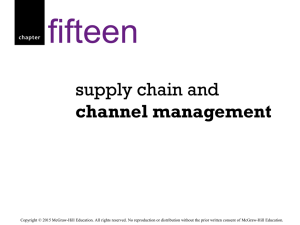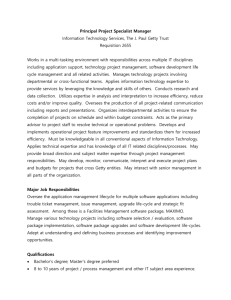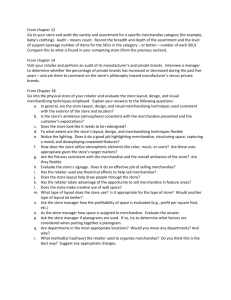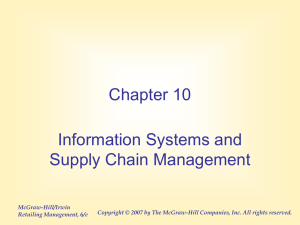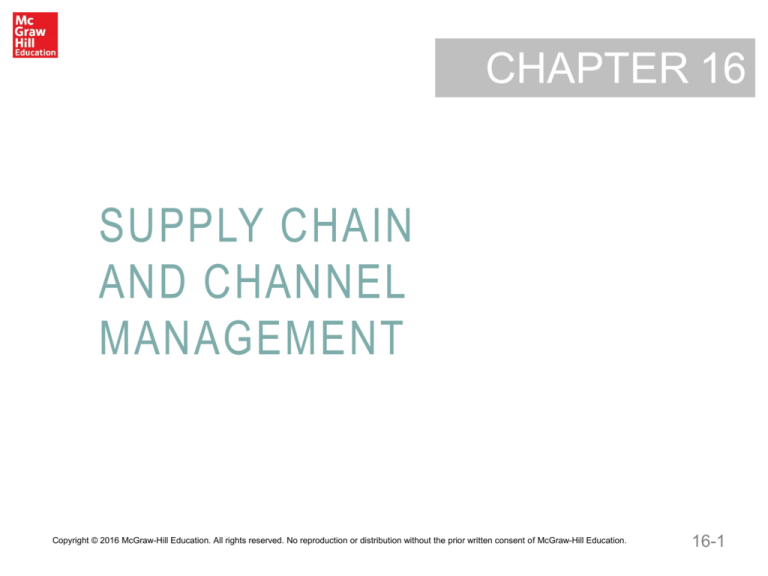
CHAPTER 16
SUPPLY CHAIN
AND CHANNEL
MANAGEMENT
Copyright © 2016 McGraw-Hill Education. All rights reserved. No reproduction or distribution without the prior written consent of McGraw-Hill Education.
16-1
Supply Chain and Channel Management
LEARNING OBJECTIVES
LO1
LO2
LO3
LO4
Understand the importance of marketing
channels and supply chain management.
Understand the difference between direct
and indirect marketing channels.
Describe how marketing channels are
managed.
Describe the flow of information and
merchandise in the marketing channel.
16-2
Amazon
Bloomberg/Getty Images
16-3
The Importance of Marketing Channel/
Supply Chain Management
Marketing Channel
Management
Chad Baker/Getty Images
Supply Chain
Management
Ryan McVay/Getty Images
16-4
Supply Chain Management
16-5
Behind the Scenes at Costco
16-6
Marketing Channels Add Value
16-7
Marketing Channels Add Value
Reduce number of
transactions
Increase value for
consumers
More efficient and
effective
http://www.youtube.com/watch?v=NeK5ZjtpO-M
16-8
Marketing Channel Management Affects
Other Aspects of Marketing
Fulfilling delivery promises
Meeting customer expectations
Reliant on an efficient supply chain
Courtesy Zara International, Inc.
Courtesy Zara International, Inc.
16-9
Designing Marketing Channels
Direct Channel
Direct Channel
One Intermediary
Direct Channel
Two Intermediaries
Manufacturer
Manufacturer
Manufacturer
Wholesaler
Customer
Retailer
Retailer
Customer
Customer
16-10
Horizontal Conflict
Managing the Marketing Channel
and Supply Chain
Manufacturer
Retailer 1
Retailer 2
Retailer 3
Horizontal Conflict
16-11
Managing the Marketing Channel
and Supply Chain through Vertical Marketing
Systems
Independent or conventional supply chain
Independent
marketing
channel
Vertical marketing
channel
16-12
Types of Vertical Marketing Systems
Administered
vertical
marketing
system
Contractual
vertical
marketing
system
Corporate
vertical
marketing
system
16-13
Power
Power
Reward
Coercive
Referent
Expertise
Information
Legitimate
16-14
Managing Marketing Channels and Supply
Chains Through Strategic Relationships
Common Goals
Open
Communications
Mutual Trust
Interdependence
Strategic
Relationships
Credible
Commitments
16-15
Used by Permission of Deutsch Inc as Agent for National
Fluid Milk Processor Promotion Board
Relationship of supply chain members
16-16
CHECK YOURSELF
1. What is the difference between an indirect and
a direct marketing channel?
2. What are the differences among the three
types of vertical marketing systems?
3. How do firms develop strong strategic
partnerships with their marketing channel
partners?
16-17
Making Information Flow
through Marketing Channels
16-18
Data Warehouse
Electronic Data Interchange
Photo by Cabela’s
Cycle time
Easily analyzed
and used
Quality of
communications
16-19
Vendor-Managed Inventory
DH Kong/Plush Studios/Getty Images
16-20
CHECK YOURSELF
1. What are the marketing channel links
associated with each information flow?
2. How do marketing channel members use data
warehouses to make decisions?
3. What is EDI and how is it used?
4. Why do some marketing channels use VMI,
while others do not?
16-21
Making Merchandise Flow
Through Marketing Channels
16-22
Bakery with Conscience
16-23
How does Dell’s Merchandise Flow
How does Dell’s
Merchandise Flow
Courtesy Dell, Inc.
16-24
Distribution Center
versus Direct Store Delivery
What are the advantages
of a distribution center?
Mario Tama/Getty Images
16-25
The Distribution Center
Management of inbound transportation
Receiving and checking using UPC and RFID
Storing and Cross-Docking
Getting Merchandise Floor Ready
Preparing to ship
Shipping to store
ABC News Segment
on a Walgreens Warehouse
16-26
Inbound Transportation
Dispatcher
coordinates deliveries
Manufacturer may
pay transportation
expenses or retailers
may negotiate directly
with trucking
companies and pay
expenses
Steve Cole/Photodisc/Getty Images
16-27
Receiving and Checking
Receiving
Arrival
receipt
Checking
Undamaged
Radio
Frequency
Distribution
(RFID) Tags
Container
computer
chips
David Buffinton/Getty Images
Ordered =
received
Photo by Scott Olson/Getty Images
16-28
Storing and Cross-Docking
Traditional
Cross-docking
Combinations
Walter Hodges/Digital Vision/Getty Images
16-29
Getting Merchandise Floor-Ready
Ticketing and marking
Increasingly firms are forcing
suppliers to ship floor ready
merchandise
16-30
Shipping Merchandise to Stores
Shipping
merchandise to stores
is complex for multistore chains
Distribution centers
use sophisticated
routing and
scheduling systems
Ryan McVay/Getty Images
16-31
Courtesy Tubular Steel, Inc.
Inventory Management
Through Just-In-Time Systems
Just-in-time (JIT)
Quick response (QR)
Zappos
16-32
Benefits of JIT Systems
Reduced lead time
James Leynse/Corbis
Increased product
availability and lower
inventory investment
16-33
CHECK YOURSELF
1. How does merchandise flow through a typical
marketing channel?
2. Why have just-in-time supply chain systems
become so popular?
16-34


